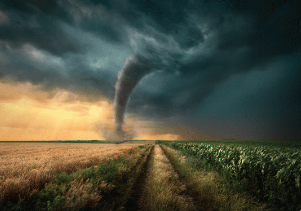A rotating column of air
1) ................................................................................................
A tornado is a rotating column of air that reaches from a thunderstorm to the ground. The most violent tornadoes can cause huge destruction with wind speeds of up to 300 mph. They can destroy large buildings, pull trees out of the ground and blow vehicles hundreds of metres. They can make a path of damage more than one mile wide and 50 miles long. In an average year, 1000 tornadoes are reported in America.
2) ................................................................................................
Most tornadoes come from thunderstorms. You need warm, moist air from the Gulf of Mexico and cool, dry air from Canada. When these two forms of air meet, they create instability in the atmosphere. A change in wind direction and an increase in wind speed create an invisible, horizontal spinning effect. Rising air moves the rotating air from horizontal to vertical. Then the storm is full of a spinning area that is 2-6 miles wide and spinning.
3) ................................................................................................
For a tornado to form, several conditions are needed. A lot of moisture is necessary to help develop a thunderstorm, and a different form of air is needed to lift the moist air up high. After the air begins to rise and becomes very wet, it might continue rising and produce a thunderstorm cloud if the atmosphere is unstable. An unstable atmosphere is created when the temperature drops fast as you go higher up. Finally, tornadoes usually form where low and high winds are strong and also turn in a clockwise direction as they go up.
4) ................................................................................................ Tornadoes can be a traditional cone shape or sometimes a rope shape. Some look smoky and others have small, individual tornadoes around a central tornado. Others are nearly invisible, with only swirling dust at ground levels.

